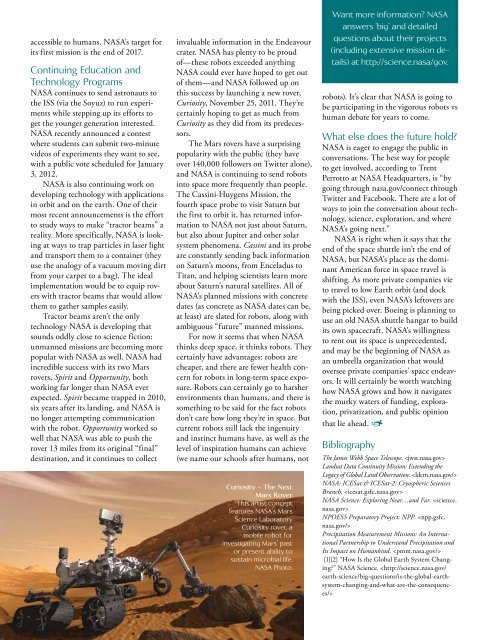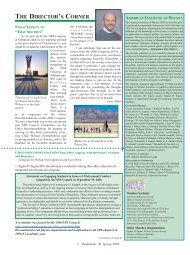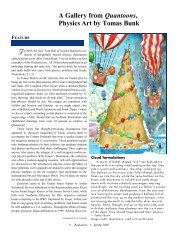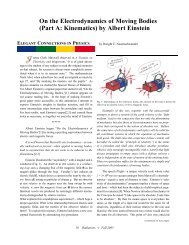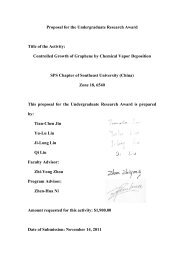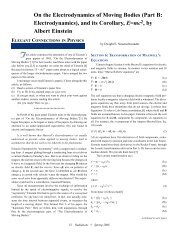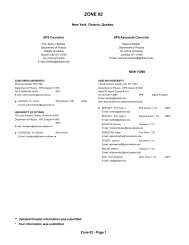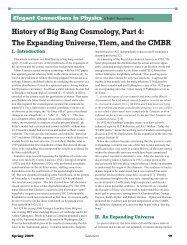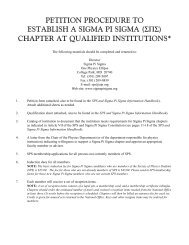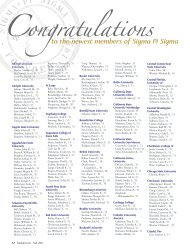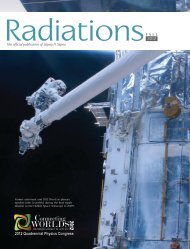Download a PDF of the entire issue - Sigma Pi Sigma
Download a PDF of the entire issue - Sigma Pi Sigma
Download a PDF of the entire issue - Sigma Pi Sigma
You also want an ePaper? Increase the reach of your titles
YUMPU automatically turns print PDFs into web optimized ePapers that Google loves.
accessible to humans. NASA’s target for<br />
its first mission is <strong>the</strong> end <strong>of</strong> 2017.<br />
Continuing Education and<br />
Technology Programs<br />
NASA continues to send astronauts to<br />
<strong>the</strong> ISS (via <strong>the</strong> Soyuz) to run experiments<br />
while stepping up its efforts to<br />
get <strong>the</strong> younger generation interested.<br />
NASA recently announced a contest<br />
where students can submit two-minute<br />
videos <strong>of</strong> experiments <strong>the</strong>y want to see,<br />
with a public vote scheduled for January<br />
3, 2012.<br />
NASA is also continuing work on<br />
developing technology with applications<br />
in orbit and on <strong>the</strong> earth. One <strong>of</strong> <strong>the</strong>ir<br />
most recent announcements is <strong>the</strong> effort<br />
to study ways to make “tractor beams” a<br />
reality. More specifically, NASA is looking<br />
at ways to trap particles in laser light<br />
and transport <strong>the</strong>m to a container (<strong>the</strong>y<br />
use <strong>the</strong> analogy <strong>of</strong> a vacuum moving dirt<br />
from your carpet to a bag). The ideal<br />
implementation would be to equip rovers<br />
with tractor beams that would allow<br />
<strong>the</strong>m to ga<strong>the</strong>r samples easily.<br />
Tractor beams aren’t <strong>the</strong> only<br />
technology NASA is developing that<br />
sounds oddly close to science fiction:<br />
unmanned missions are becoming more<br />
popular with NASA as well. NASA had<br />
incredible success with its two Mars<br />
rovers, Spirit and Opportunity, both<br />
working far longer than NASA ever<br />
expected. Spirit became trapped in 2010,<br />
six years after its landing, and NASA is<br />
no longer attempting communication<br />
with <strong>the</strong> robot. Opportunity worked so<br />
well that NASA was able to push <strong>the</strong><br />
rover 13 miles from its original “final”<br />
destination, and it continues to collect<br />
invaluable information in <strong>the</strong> Endeavour<br />
crater. NASA has plenty to be proud<br />
<strong>of</strong>—<strong>the</strong>se robots exceeded anything<br />
NASA could ever have hoped to get out<br />
<strong>of</strong> <strong>the</strong>m—and NASA followed up on<br />
this success by launching a new rover,<br />
Curiosity, November 25, 2011. They’re<br />
certainly hoping to get as much from<br />
Curiosity as <strong>the</strong>y did from its predecessors.<br />
The Mars rovers have a surprising<br />
popularity with <strong>the</strong> public (<strong>the</strong>y have<br />
over 140,000 followers on Twitter alone),<br />
and NASA is continuing to send robots<br />
into space more frequently than people.<br />
The Cassini-Huygens Mission, <strong>the</strong><br />
fourth space probe to visit Saturn but<br />
<strong>the</strong> first to orbit it, has returned information<br />
to NASA not just about Saturn,<br />
but also about Jupiter and o<strong>the</strong>r solar<br />
system phenomena. Cassini and its probe<br />
are constantly sending back information<br />
on Saturn’s moons, from Enceladus to<br />
Titan, and helping scientists learn more<br />
about Saturn’s natural satellites. All <strong>of</strong><br />
NASA’s planned missions with concrete<br />
dates (as concrete as NASA dates can be,<br />
at least) are slated for robots, along with<br />
ambiguous “future” manned missions.<br />
For now it seems that when NASA<br />
thinks deep space, it thinks robots. They<br />
certainly have advantages: robots are<br />
cheaper, and <strong>the</strong>re are fewer health concern<br />
for robots in long-term space exposure.<br />
Robots can certainly go to harsher<br />
environments than humans, and <strong>the</strong>re is<br />
something to be said for <strong>the</strong> fact robots<br />
don’t care how long <strong>the</strong>y’re in space. But<br />
current robots still lack <strong>the</strong> ingenuity<br />
and instinct humans have, as well as <strong>the</strong><br />
level <strong>of</strong> inspiration humans can achieve<br />
(we name our schools after humans, not<br />
Curiosity - The Next<br />
Mars Rover<br />
This artist concept<br />
features NASA’s Mars<br />
Science Laboratory<br />
Curiosity rover, a<br />
mobile robot for<br />
investigating Mars’ past<br />
or present ability to<br />
sustain microbial life.<br />
NASA Photo.<br />
Want more information? NASA<br />
answers ‘big’ and detailed<br />
questions about <strong>the</strong>ir projects<br />
(including extensive mission details)<br />
at http://science.nasa/gov.<br />
robots). It’s clear that NASA is going to<br />
be participating in <strong>the</strong> vigorous robots vs<br />
human debate for years to come.<br />
What else does <strong>the</strong> future hold?<br />
NASA is eager to engage <strong>the</strong> public in<br />
conversations. The best way for people<br />
to get involved, according to Trent<br />
Perrotto at NASA Headquarters, is “by<br />
going through nasa.gov/connect through<br />
Twitter and Facebook. There are a lot <strong>of</strong><br />
ways to join <strong>the</strong> conversation about technology,<br />
science, exploration, and where<br />
NASA’s going next.”<br />
NASA is right when it says that <strong>the</strong><br />
end <strong>of</strong> <strong>the</strong> space shuttle isn’t <strong>the</strong> end <strong>of</strong><br />
NASA, but NASA’s place as <strong>the</strong> dominant<br />
American force in space travel is<br />
shifting. As more private companies vie<br />
to travel to low Earth orbit (and dock<br />
with <strong>the</strong> ISS), even NASA’s leftovers are<br />
being picked over. Boeing is planning to<br />
use an old NASA shuttle hangar to build<br />
its own spacecraft. NASA’s willingness<br />
to rent out its space is unprecedented,<br />
and may be <strong>the</strong> beginning <strong>of</strong> NASA as<br />
an umbrella organization that would<br />
oversee private companies’ space endeavors.<br />
It will certainly be worth watching<br />
how NASA grows and how it navigates<br />
<strong>the</strong> murky waters <strong>of</strong> funding, exploration,<br />
privatization, and public opinion<br />
that lie ahead. r<br />
Bibliography<br />
The James Webb Space Telescope. <br />
Landsat Data Continuity Mission: Extending <strong>the</strong><br />
Legacy <strong>of</strong> Global Land Observation. <br />
NASA: ICESat & ICESat-2: Cryospheric Sciences<br />
Branch. <br />
NASA Science: Exploring Near…and Far. <br />
NPOESS Preparatory Project: NPP. <br />
Precipitation Measurement Missions: An International<br />
Partnership to Understand Precipitation and<br />
Its Impact on Humankind. <br />
[1][2] “How Is <strong>the</strong> Global Earth System Changing?”<br />
NASA Science. <br />
28 Radiations Fall 2011


